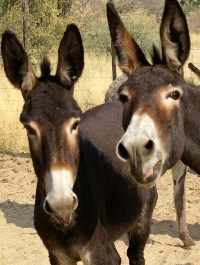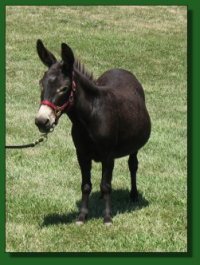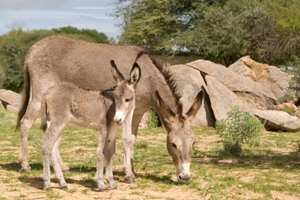The True Story Behind the Donkey
 The first findings of
donkeys come from archaeological records and
ancient art. In the Egyptian tomb of King
Tutankhamen, archaeologists found depictions
of donkey hunts. Donkeys were used for many
purposes in the ancient times. Not only were
these animals hunted but they were also
domesticated. They provided a means of
transportation for agricultural goods and
humans themselves.
The first findings of
donkeys come from archaeological records and
ancient art. In the Egyptian tomb of King
Tutankhamen, archaeologists found depictions
of donkey hunts. Donkeys were used for many
purposes in the ancient times. Not only were
these animals hunted but they were also
domesticated. They provided a means of
transportation for agricultural goods and
humans themselves.
The domesticated donkey is believed to be the descendent of the wild ass, Equss africanus. More specifically, donkeys come from the Somali and Nubian wild asses. The first captivity of the wild ass was in Egypt and western Asia dated back as early as 2800 B.C. to 2500 B.C. It was not until 1000 B.C. that the donkey became the common means of transportation through Egypt, Asia , and parts of Europe.
 Donkeys even found their
way to the New World through the voyage of Christopher Columbus.
He
aided in the migration of these animals when
he brought four males and two females to America.
Once in the Americas, they were bred and
produced mule offspring. The mules were used
by the Spanish throughout their conquests.
It was not until the gold rush that
donkeys
become increasingly important in America.
During this time, donkeys were used
for hauling gold around the mountainous
mines.
Donkeys even found their
way to the New World through the voyage of Christopher Columbus.
He
aided in the migration of these animals when
he brought four males and two females to America.
Once in the Americas, they were bred and
produced mule offspring. The mules were used
by the Spanish throughout their conquests.
It was not until the gold rush that
donkeys
become increasingly important in America.
During this time, donkeys were used
for hauling gold around the mountainous
mines.
The domestication of donkeys continues to be important today. They are used for transportation of agricultural goods, building materials, and people all over the world.
In 1929, miniature donkeys came to the United States. Although not as strong, miniature donkeys are used for the same main purposes as regular donkeys. They are able to carry a hundred pound load of goods and produce, wagons, or a passenger. They also make great pet companions or guard animals because they are very loyal. The picture to the right is a black miniature jennet at the Elms Farm.
Reproduction
 Donkeys
do not form lasting bonds but
mate sexually during the summer months. They
generally give birth in the spring because
the gestation period is about eleven months.
If they are a part of a
herd, mothers tend to give birth away
from the others and
return three months after the birthing
process. A baby foal
is fully developed at birth
then grows from its mother's milk until it
finally matures and is weaned after a year. After two years, the foal
is now considered to be sexually
mature and can produce
offspring of its own. The life span for wild
donkeys is generally 25-30 years. Captive
donkeys, on the other hand, can live up to
40-50 years.
Donkeys
do not form lasting bonds but
mate sexually during the summer months. They
generally give birth in the spring because
the gestation period is about eleven months.
If they are a part of a
herd, mothers tend to give birth away
from the others and
return three months after the birthing
process. A baby foal
is fully developed at birth
then grows from its mother's milk until it
finally matures and is weaned after a year. After two years, the foal
is now considered to be sexually
mature and can produce
offspring of its own. The life span for wild
donkeys is generally 25-30 years. Captive
donkeys, on the other hand, can live up to
40-50 years.
Interesting fact:
Most people have heard of the mule, the
sterile offspring of of a male donkey and
female horse, but have you heard of a Hinny?
A Hinny is a cross between
a female jenny and a male horse. What about
a Zonkey, Zebroid, Zebrass,
or Zedonk? These are names
for the offspring of a Zebra and a donkey. This
information is compliments of
themules.net
How do donkeys interact with other organisms?
Copyright © 2007, Design by: Sunlight webdesign